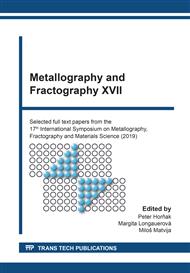[1]
J.L. Chermant, M. Coster, Quantitative fractography, Journal of Materials Science 14, 3 (1979) 509-534.
DOI: 10.1007/bf00772710
Google Scholar
[2]
N.T. Goldsmith, R.J.H. Wanhill, L. Molent, Quantitative fractography of fatigue and an illustrative case study, Engineering Failure Analysis 96 (2019) 426-435.
DOI: 10.1016/j.engfailanal.2018.10.013
Google Scholar
[3]
J.R. Tarpani, C.O.F.T. Ruckert, M.T. Milan, R.V. Silva, A. Rosato, R.N. Pereira, W.W. Bose, D. Spinelli, Estimating fatigue life under variable amplitude loading through quantitative fractography – A case study, Engineering Failure Analysis 11, 4 (2004) 547-559.
DOI: 10.1016/j.engfailanal.2003.09.004
Google Scholar
[4]
K. Gopalakrishnan, J.J. Mecholsky, Quantitative fractography of mixed mode fracture in glass and ceramics, Journal of the European Ceramic Society 34, 14 (2014) 3247-3254.
DOI: 10.1016/j.jeurceramsoc.2014.03.019
Google Scholar
[5]
J.J. Kruzic, R.O. Ritchie, Fatigue of mineralized tissues: Cortical bone and dentin, Journal of the Mechanical Behavior of Biomedical Materials 1, 1 (2008) 3-17.
DOI: 10.1016/j.jmbbm.2007.04.002
Google Scholar
[6]
J. Cwajna, S. Roskosz, Application of confocal laser scanning microscopy, atomic force microscopy, and the profilometric method in quantitative fractography, Materials Characterization 46, 2-3 (2001) 183-187.
DOI: 10.1016/s1044-5803(01)00122-x
Google Scholar
[7]
H. Lauschmann, N. Goldsmith, Textural Fractography of Fatigue Fractures, in: Alphonse F. Lignelli (Ed.), Fatigue Crack Growth: Mechanics, Behavior and Prediction, Nova Science Publishers, Inc., 2009, 125-166.
Google Scholar
[8]
H. Lauschmann, Z. Sekerešová, F. Šiška, Recent developments in textural fractography of fatigue fractures. Proceedings of the 4th International Conference on CRACK PATHS (CP 2012). A. Carpinteri, F. Iacoviello, L. P. Pook and L. Susmel (Eds.), Gaeta (Italy), 19-21 September 2012, 807-814.
DOI: 10.1016/j.ijfatigue.2013.07.008
Google Scholar
[9]
Z. Sekerešová, Analysis of textural features of three-dimensional reconstructions of fatigue crack surfaces in relation to crack growth rate. Ph.D. Thesis (in Czech). FNSPE, Czech Technical University in Prague, (2011).
Google Scholar
[10]
T. Jílková, Reconstruction of the history of fatigue crack growth on the basis of mesoscopic morphological characteristics of fracture surfaces. Master Thesis (in Czech). FNSPE, Czech Technical University in Prague, (2015).
Google Scholar
[11]
I. Nedbal, H. Lauschmann, J. Siegl, J. Kunz, Fractographic reconstitution of fatigue crack history - Part II. Fatigue & Fracture of Engineering Materials & Structures 31 (2008) 177-183.
DOI: 10.1111/j.1460-2695.2007.01212.x
Google Scholar
[12]
H. Lauschmann, J. Kukal, Stepwise Optimization of a Multilinear Model. In: R. Lechnerová and V. Beneš (Eds.), Book of Abstracts S4G. 7th International Conference on Stereology, Spatial Statistics and Stochastic Geometry, Matfyzpress, Praha, (2012), 126-127.
Google Scholar


